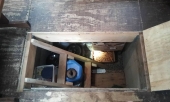Will take some pics. Not sure how to send from my phone but will figure out.
Not sure when this was built but it's been here as long as I can remember - my parents moved into this house in 1962 so it's lasted this long without the walls breaking down. I don't remember ever seeing water trickling in. No one every grew mushrooms in there but I was so focused on the veggies and ferments, I forgot about the mushrooms! This makes getting it ready to go even more exciting!
I can see a little daylight in a couple of places.
Looks like the humidity should be very high - 85-90%, so the important thing might be to just keep the air moving. Have to get a moisture meter but I put a dehumidifier in there before I knew about the 85-90%. Just plugged it in- 88% - perfect!
webpage
After I posted this, I talked to our local permaculture teacher (Adam Dusen, Hundred Fruit Farm) and while this isn't his area of expertise, he recommended the fan as did another very knowledgeable friend. A friend has an 8" fan we could install.
Elliot Coleman is right, of course! It just smells musty in there but maybe they all do if the original dirt is exposed.
Thank you all, will do the pics when I have time on Sunday - making soup for the last day of the Wrightstown Farmers Market - mushroom/pumpkin, all from local ingredients (except for the olive oil). We have a wonderful mushroom grower here, Primordia.
Thank you all for your input!

 3
3








 5
5




 2
2




 5
5




 3
3




 2
2












 4
4




 1
1








